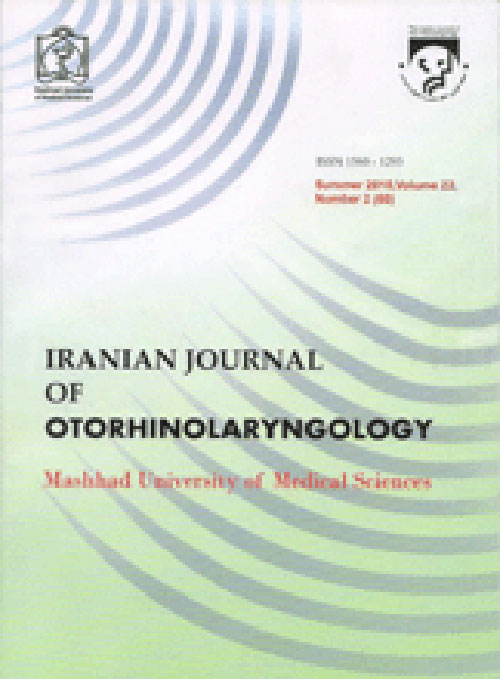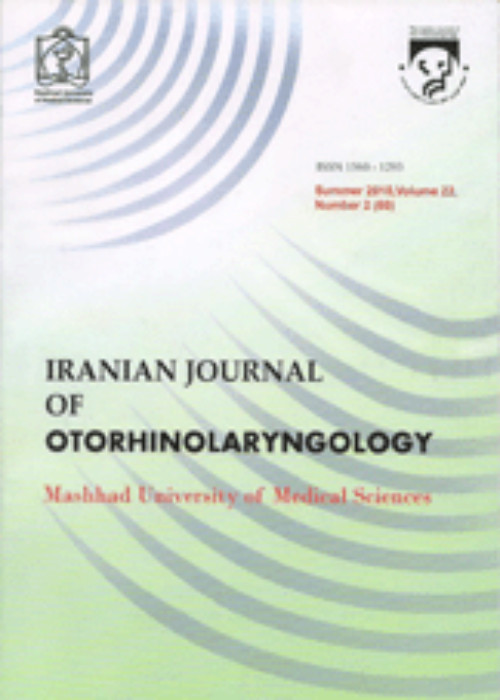فهرست مطالب

Iranian Journal of Otorhinolaryngology
Volume:30 Issue: 1, Jan 2018
- تاریخ انتشار: 1396/10/26
- تعداد عناوین: 10
-
-
Pages 3-10IntroductionSubcutaneous and mediastinal emphysema is a rare complication after tonsillectomy. This case presentation and literature review summarizes the existing literature on this unusual complication.Materials And MethodsThis study presents a case of a 21-year-old man who developed a cervical subcutaneous emphysema 6 days after tonsillectomy, whereby conservative treatment produced spontaneous resolution. A proper analysis of this case also required undertaking a systematic search in MEDLINE/PubMed and SCOPUS electronic databases concerning this rare complication, without language restrictions.ResultsBased on our criteria, we identified 41 reports including 43 individual cases, in which patients were mostly young and equally distributed between the genders (17 males and 22 females, two unknown). The treatment was mainly conservative and consisted of observation and/or antibiotic therapy.ConclusionSubcutaneous or mediastinal emphysema is an uncommon complication after tonsillectomy. It is important that clinicians become aware of this rare complication, which requires a close monitoring of the patient.Keywords: Tonsillectomy, Mediastinal Emphysema, Subcutaneous Emphysema
-
Pages 11-18IntroductionSince the days of Hippocrates, many modifications have been proposed in endonasal dacrocystorhinostomy (DCR), with the use of new drugs and implants showing variable results. The objective of this study was to analyze whether the use of silicon tubing or mitomycin C administration has an added advantage over conventional endonasal DCR.Materials And MethodsA randomized controlled trial of 150 patients between the ages of 6 and 70 years presenting with epiphora was performed. Patients were randomly divided into three groups: endonasal DCR with mitomycin C administration, endonasal DCR with silicon stenting, or conventional endonasal DCR. Patients were followed up on Days 15, 30, 60 and 90 postoperatively for sac syringing to confirm patency.ResultsThe majority of patients (28.7%) were in the fourth decade of life, with a female predominance (65.3%). Dacrocystitis was most commonly seen in the left eye (58.7%). An intergroup comparison was performed using the Kruskal-Wallis test at the end of 3 and 5 months. The results suggest that the success rate was significantly higher in patients with a silicone stent (P=0.04) as compared with the other two groups, although no significant difference in failure rate was seen between patients on mitomycin C and conventional therapy (P=0.132 at Month 3 and P=0.481 at Month 5, Mann-Whitney U-test).ConclusionOur study shows that silicone tube stenting had a better success rate compared with the other two groups, with no significant statistical difference between the use of mitomycin C and the conventional technique.Keywords: Conventional, Dacrocystitis, Endonasal dacrocystorhinostomy, Mitomycin C, Silicone tubing
-
Pages 19-25IntroductionProcessing odor information by the olfactory system depends greatly on the odor concentration. In order to use an odorant in a smell identification test (SIT), the minimum identification concentration (MIC) needs to be determined.Materials And MethodsThis study was conducted in 60 healthy native individuals aged 20 to 60 years, selected from patients companions in a tertiary hospital. In the first step, 25 odorants were presented to evaluate familiarity among the subjects. Then, the MICs for the eligible odorants were measured using the ascending method of limits.ResultsOut of 25 odorants, only one (cacao) was distinguished by less than 70% of the subjects, and was therefore removed from the list. The MICs of the remaining 24 odorants ranged from 6.87±2.74% for menthol to 27.62±18.98% for cantaloupe. There was significant correlation between age and the MIC only for coffee (P=0.02, r=−0.300). There was a significant difference in MIC between men and women only for hazelnut (P=0.03).ConclusionWe present the MICs of 24 culturally-familiar odorants in a sample of the Persian population in a SIT.Keywords: Culture, Identification, Smell, Odorants
-
Pages 27-31IntroductionThe most common type of velopharyngeal valve (VPV) closure is a matter of controversy.The aim of this study was to estimate the most common type of VPV closure, including identification of the type and grade of VPV closure among Egyptian children.Materials And MethodsThis study included patients who were candidates for adenotonsillectomy. In these cases, video-nasoendoscopy and speech assessment were performed prior to surgery in addition to otorhinolaryngology examination and preoperative laboratory tests.ResultsBy examination of 97 patients, video-nasoendoscopy of the VPV revealed that 49 patients had coronal VPV closure (50.5%), 48 patients had circular VPV closure (49.5%) and no patients had sagittal VPV closure.ConclusionCoronal and circular closure are the main types of VPV closure in Arabic-speaking children, as neither sagittal closure nor circular closure with Passavants ridge were detected in this study. Therefore, revision of the methods of repair for persistent velopharyngeal insufficiency (VPI) is required.Keywords: Adenotonsillectomy, Speech assessment, Velopharyngeal valve, Video-nasoendoscopy
-
Pages 33-40IntroductionOlfactory loss in patients with chronic rhinosinusitis has been measured by different methods. However, the results have been variable, and it is not clear whether endoscopic sinus surgery significantly improves olfactory function. This study was performed to evaluate the influence of endoscopic sinus surgery on olfactory function in patients with chronic rhinosinusitis.Materials And MethodsIn this prospective analytic study, 73 patients (mean age, 39.63±12.94 years) with a diagnosis of polyps and sinusitis during 2011 were studied. The olfaction test was performed with three solutions; one with no odor (water) and two with phenylethyl alcohol (50% and 90% dilution, respectively). The patients olfaction state were graded as no olfaction, or low, moderate or good olfaction before and 1 and 3 months after surgery, and was given scores between 0 and 3 and evaluated quantitatively.ResultsRight-side olfaction was improved in 68.5% and left side in 67.1% of patients. Mean olfaction score on the right and left side was significantly improved after surgery in comparison with basic scores (before and after on the right side: 0.95±0.88 and 2.02±1.04; before and after on the left side: 1.02±0.84 and 2.00±1.21; both PConclusionIn patients with rhinosinusitis, endoscopic sinus surgery has considerable effect in improving olfactory function.Keywords: Nasal polyp, Nasal endoscopic surgery, Olfaction, Sinusitis
-
Pages 41-47IntroductionDue to the prevalence of otomycosis in the north of Iran, which has a humid climate, this study aimed to examine the recurrence rate of otomycosis in Iranian patients.Materials And MethodsThis cross-sectional study was performed in all patients suspected of otomycosis referred to the Otorhinolaryngology Clinic of Ayatollah Rouhani Hospital of Babol. Demographic and clinical data of patients as well as their symptoms were collected in a checklist at referral time and also 14 days after referral.ResultsThe results showed that 11 (7.3%) cases had a recurrence of otomycosis. There was no significant relationship between the incidence of otomycosis and age or sex (P=0.86 and 0.88, respectively). Septate mycelium was the most observed element on direct examination. Aspergillus flavus was the most common pathogenic agent in culture media, followed by Aspergillus niger and Candida albicans.ConclusionBased on the results of this research in Babol, the recurrence of otomycosis was 7.3% and was related to swelling and erythema in ear canal.Keywords: External ear, Fungal infection, Otomycosis, Recurrence rate
-
Pages 49-54IntroductionPapillary thyroid carcinoma (PTC) constitutes 7585% of all thyroid cancers. PTC usually presents as a subtle, commonly slow-growing, painless thyroid mass or a solitary nodule in the neck. This presentation of a cystic neck lump, without the presence of a thyroid nodule, may imitate the course of a benign disease, thus delaying diagnosis and proper treatment.
Case Report: Three cases that had been initially presented as a cystic neck lesion in which a benign etiology was considered primarily were compiled in this study. PTC was only diagnosed after surgical excision of these cystic neck lesions in the first two cases, and after performing fine needle aspiration cytology (FNAC) and an 18fluorine-fluorodeoxyglucose positron emission tomography computed tomography (18F-FDG-PET CT) scan in the latter case.ConclusionPTC can sometimes present as a cystic neck mass; a presentation which is usually related to a benign lesion. This case series emphasizes that patients who appear to have a solitary cystic neck mass must be treated with a high index of clinical suspicion. Although not a first-line imaging modality, 18F-FDG-PET can be extremely useful in assessing patients with a cystic neck lesion, where diagnosis is still uncertain after standard investigations such as ultrasonography and FNAC have been performed.Keywords: Cystic neck lesion, FNAC, Papillary thyroid carcinoma, 18 F-FDG-PET CT scan -
Pages 55-59Introduction
SAPHO syndrome is defined as the association of a group of rare sterile osteoarticular disorders and inflammatory skin diseases whose etiology, although not yet determined, probably involves genetic, immunological and infectious mechanisms. The recurrent multifocal osteomyelitis, an inflammatory disease, can be associated with this syndrome even as a single event.
Case ReportA case of a young female patient, with a definite diagnosis of SAPHO and an inflammatory mandibular atypical disease for which therapeutic options with immunosuppressants were being used, is reported. The adverse evolution of the clinical conditions led to the hypothesis that the patient suffered from associated mandibular odontogenic bacterial osteomyelitis. The extraction of all teeth was recommended. After our evaluation, we recommended a conservative treatment, and after 2 months of treatment with an endovenous antibiotic, the patient showed improvement of clinical and laboratory results.
ConclusionEarly diagnosis is necessary to avoid successive and unnecessary tooth loss in the treatment of chronic osteomyelitis mandibular.
Keywords: Mandibular involvement, Osteomyelitis, SAPHO syndrome -
Pages 61-63IntroductionTreatment of edentulous atrophic mandible with severe atrophy is a challenge based on local conditions and systemic diseases confronted by the age group affected. If bone grafting is indicated, it is often used in lateral or inferior aspects of the mandible.
Case Report: A 70-year-old male with a unilateral fracture of the atrophied left mandibular body was managed by lingual bone grafting and inferior border miniplate fixation to prevent two common problems after fracture healing; the need for plate removal before denture fabrication and facial asymmetry in the unilateral body fracture.ConclusionIf bone grafting is indicated in the management of displaced edentulous mandibular fracture with severe atrophy, a combination of plating at the inferior border of the mandible and lingual corticocancellous bone grafting should be considered in treatment planning.Keywords: Bone graft, Edentulous mandible, Fracture -
Pages 65-68IntroductionPrimary squamous cell carcinoma (SCC) of the thyroid gland is one of the rarest types of all reported thyroid malignancies worldwide. It is very aggressive in nature and carries a poor prognosis. The surgical resection with adjuvant radiotherapy and chemotherapy is the most recommended treatment despite its poor reported outcome.
Case Report: A 74-year-old woman presented with a rapidly progressive neck swelling, with hoarseness and compressive symptoms. Physical examination revealed a multilobulated firm thyroid mass with unilateral vocal cord palsy. Histopathological findings confirmed the diagnosis of SCC while radiological investigations and panendoscopy findings ruled out the possibility of other primary tumors. A surgical intervention was performed; however, the patient eventually succumbed to death prior to undergoing an oncological treatment.ConclusionWith no standard consensus to guide the management plan, SCC of the thyroid gland presents a great challenge for the managing team to come up with the best treatment option, due to its unfavorable rate of survival.Keywords: Squamous cell carcinoma, Thyroid gland, Therapeutics


